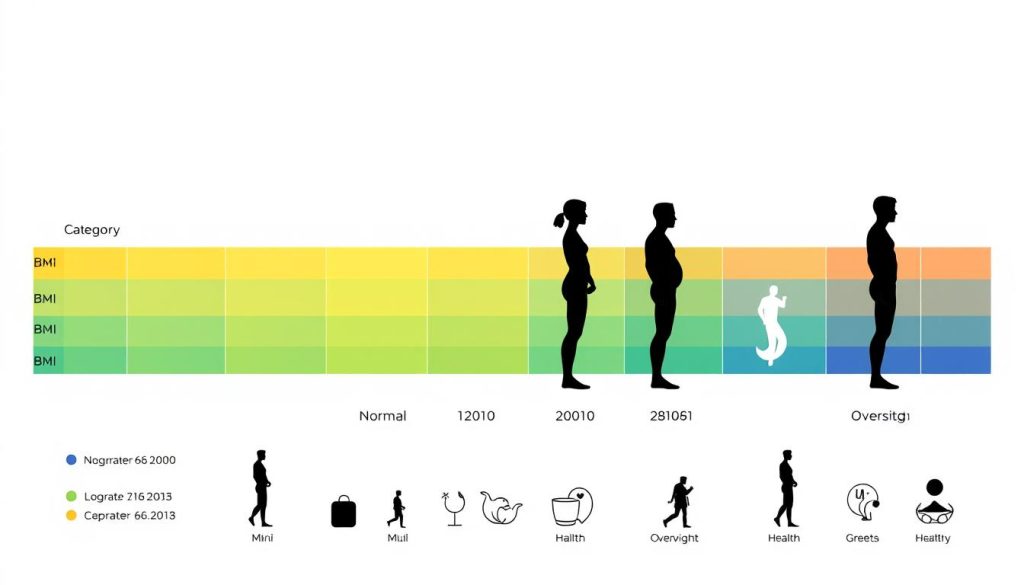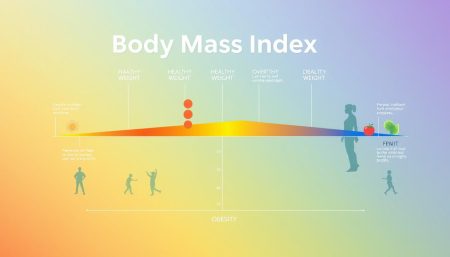Understanding your health often begins with knowing your body mass index (BMI). BMI is a key tool used by doctors to check weight status and help people live healthier. It’s a simple way to see if your weight is in balance with your height, without needing to do lots of tests or spend a lot of money.
Using the BMI formula can help you see where you stand on the weight scale. It can tell you if you’re underweight, at a healthy weight, overweight, or obese. Knowing your BMI is important because it can show your risk for diseases like diabetes and heart problems. If you’re trying to lose weight, knowing your BMI is key. For tips on losing weight with Ozempic and healthy habits, check out this link.
Health and wellness are personal journeys. Learning about BMI and how it affects your health goals is empowering. Whether you’re just starting or looking to change your fitness and weight management plan, BMI is a simple yet important tool. Let’s explore how BMI works and its role in your health.
Key Takeaways
- Learning how to calculate your body mass index is fundamental to weight management.
- The BMI formula provides a quick insight into an individual’s health and wellness status.
- BMI can help you shape your personal health goals and track your progress.
- It is essential to understand BMI’s role in the context of overall health and disease risk.
- Educational resources like Ozempic’s regimen offer distinct ways to utilize BMI in conjunction with weight loss strategies.
Understanding Body Mass Index (BMI)
Body Mass Index, or BMI, is a simple way to measure body mass worldwide. It uses a ratio of weight and height. This method helps categorize people into different weight groups, which can impact their health.
What is BMI?
BMI is found by dividing your weight in kilograms by your height in meters squared. This gives a score that shows if you’re underweight, normal, overweight, or obese. It’s a key tool for obesity measurement.
Importance of BMI
BMI is crucial in healthcare and public health. It quickly shows a person’s health status based on their weight. It helps spot risks linked to obesity and other weight-related problems. It also helps track health trends over time.
Limitations of BMI
Even though BMI is useful, it has its limits. It doesn’t tell the difference between muscle and fat. This can lead to mistakes, like athletes being seen as overweight because of muscle. It also doesn’t consider age and sex differences.
| BMI Category | BMI Range (kg/m²) |
|---|---|
| Underweight | Less than 18.5 |
| Normal Weight | 18.5 – 24.9 |
| Overweight | 25 – 29.9 |
| Obese | 30 or Greater |
In summary, BMI gives a good look at weight and height ratio and an estimate of ideal body weight. But, doctors say to use it with other methods for a complete health picture.
The BMI Formula
Understanding the Body Mass Index (BMI) formula is key for good weight management tools. It’s a simple way to check your health and wellness and track your fitness. We’ll look at both metric and imperial systems so everyone can use it.
Metric vs. Imperial Measurements
The BMI formula changes based on the system you use. In the metric system, you divide your weight in kilograms by your height in meters squared. The imperial system uses pounds for weight and inches for height, with a special conversion factor. Let’s dive into both for a clear understanding.
Step-by-Step Calculation
To find your BMI in the metric system, follow these steps:
- Measure your weight in kilograms.
- Measure your height in meters.
- Square the height measurement (multiply the height by itself).
- Divide your weight by the squared height value.
For the imperial system, the steps are similar but include a conversion factor:
- Measure your weight in pounds.
- Measure your height in inches.
- Square the height measurement.
- Divide your weight by the squared height value.
- Multiply the result by 703 to convert it to BMI.
Both methods are great for tracking your BMI as part of your health and wellness routine. These simple steps are powerful weight management tools that offer insights into your health and fitness progress.
| Measurement System | Weight Unit | Height Unit | Formula |
|---|---|---|---|
| Metric | Kilograms | Meters | Weight (kg) / [Height (m)]^2 |
| Imperial | Pounds | Inches | [Weight (lb) / Height (in)^2] x 703 |
Calculating BMI: A Practical Guide
Finding your BMI (Body Mass Index) is key to staying healthy. It helps you know if you’re in a healthy weight range and understand your body composition analysis. This guide will show you how to use BMI calculators and do manual calculations. It also points out common mistakes to avoid for accurate results.
Using a Calculator
Online BMI calculators are quick and easy to use. Just enter your height and weight, and they do the math for you. Make sure to use calculators from trusted health websites for the most accurate results.

Manual Calculation Method
To calculate your BMI manually, use the formula: BMI = weight (kg) / (height (m))^2. This method helps you understand body composition analysis better. It’s great for tracking changes in your body over time.
Common Mistakes to Avoid
- Not updating your weight can lead to old BMI calculations.
- Using the wrong units, like pounds instead of kilograms, can cause big errors in BMI.
- Remember, a BMI in the healthy weight range doesn’t always mean you’re healthy. It’s just a starting point.
Avoiding these mistakes helps you get more accurate BMI readings. This way, you can make better health choices.
Interpreting Your BMI Results
After calculating your BMI, it’s time to understand its health implications. This guide will explain BMI categories and their health risks. It helps you see if you’re at a healthy weight and overall health status.
BMI Categories Explained
BMI is a key tool for measuring body weight. It sorts weight into categories based on health risks. Here’s a simple breakdown:
| BMI Range (kg/m2) | Category |
|---|---|
| Under 18.5 | Underweight |
| 18.5 – 24.9 | Normal Weight |
| 25 – 29.9 | Overweight |
| 30 and above | Obesity |
Health Implications of BMI
Knowing the health implications of your BMI is key. Each range has its own health risks:
- Underweight: May show malnutrition or health problems.
- Normal Weight: Lowers the risk of heart disease, diabetes, and some cancers.
- Overweight: Raises the risk of high blood pressure, diabetes, and heart disease.
- Obesity: Increases the risk of stroke, heart disease, diabetes, and cancer.
While BMI is useful, remember it’s not the only factor. Body composition, lifestyle, and genetics also matter for your health.
In summary, your BMI gives important health insights. But, it’s just one piece of the puzzle. Always look at it with other health measures. Talk to a doctor for a full health picture.
BMI and Body Composition
The link between Body Mass Index (BMI) and body composition is key to understanding health. Yet, BMI has its limits. It compares weight and height but misses the mark on muscle and fat distribution. This section looks into BMI’s connection to body composition and other methods for a fuller picture.
How BMI Relates to Fat Distribution
BMI is a simple weight-to-height ratio that shows if a person’s weight is healthy for their height. But it doesn’t tell the difference between muscle and fat weight. So, someone with a lot of muscle might have a high BMI but not much body fat.
For tracking fitness, knowing where body fat is located is important. Too much visceral fat, for example, can lead to heart disease and diabetes. So, while BMI can say if you’re overweight, it doesn’t show where the fat is, which is vital for body composition analysis.
Other Methods to Assess Body Composition
Because BMI has its flaws, other ways to look at body composition have been developed. These methods give a more detailed view:
- Body Composition Scales and Bioelectrical Impedance Analysis (BIA): These tools measure how electricity flows through the body to guess fat, muscle, and water levels. They’re easy to use at home and help track fitness well.
- Skinfold Measurements: This method checks fat thickness at different body spots to guess body fat percentage. It needs calipers and some skill for accurate results.
- Dual-Energy X-ray Absorptiometry (DEXA): First used for bone scans, DEXA now accurately measures body composition. It shows muscle, bone, and fat distribution in detail.
These methods add to BMI’s value by showing what BMI can’t. They give a detailed look at body composition for better health checks and fitness tracking.
Factors Influencing BMI
It’s important to know how different things affect Body Mass Index (BMI). This helps us see if someone is at a healthy weight. It also makes body composition analysis and fitness tracking better.
Age and Gender
Age and gender play big roles in BMI. As we get older, our muscle mass goes down. This can make BMI seem off if we don’t adjust for age.
Ethnicity and Muscle Mass
People from different ethnic groups can have different body types. This affects BMI readings. Also, people with more muscle might get a wrong BMI if we only use BMI.

| Factor | Impact on BMI | Consideration in BMI Analysis |
|---|---|---|
| Age | Variation in muscle and fat distribution | Adjustments for age-specific standards |
| Gender | Different fat distribution patterns | Use gender-specific BMI thresholds |
| Ethnicity | Diverse genetic predispositions to body fat | Customize BMI interpretation per ethnicity |
| Muscle Mass | Increased weight due to muscle, not fat | Integrate BMI with body composition analysis |
Tracking Changes in BMI Over Time
Keeping a healthy weight range is key for good health. It’s also important to know how to track and understand changes in Body Mass Index (BMI) over time. Using good weight management tools helps set and track progress towards goals.
Setting Realistic Goals
Everyone’s health journey is different. So, setting goals that are within a healthy weight range is crucial. These goals should fit your health needs and lifestyle, helping you stay healthy in the long run.
- Start with small, incremental changes
- Align goals with current health needs and future aspirations
- Evaluate and adjust goals as needed to stay motivated
Monitoring Progress
Regularly checking BMI shows how well your health plans are working. It lets you make changes based on real data. This shows why using advanced weight management tools is so important for tracking.
| Time Frame | BMI | Adjusted Goals |
|---|---|---|
| Month 1 | 25 | Gain Muscle |
| Month 3 | 24 | Increase Cardio |
| Month 6 | 23 | Maintain BMI |
By keeping an eye on BMI and tweaking your health plans, you can better control your health and wellness. This approach helps reach short-term fitness goals and supports long-term health management.
Using BMI in a Healthy Lifestyle
Using Body Mass Index (BMI) in a healthy lifestyle is more than just knowing your weight. It’s about using BMI as a base for managing your health. This includes creating a diet and exercise plan that fits your body and using fitness trackers to keep track.
Combining BMI with Diet and Exercise
Starting with BMI means understanding what it says about your health. If you want to reach or keep an ideal weight, eating right is key. Choose foods that are good for you, not just tasty.
- Fruits and vegetables for vitamins and minerals
- Lean proteins to support muscle maintenance and growth
- Whole grains for sustained energy
- Healthy fats for neurological health
Along with diet, exercise is also important. The right workout depends on your BMI. Activities like walking, swimming, or yoga can help manage your BMI. It’s also important to track your progress with fitness trackers.
Seeking Professional Guidance
Getting help from experts can make a big difference. Dieticians and nutritionists can help plan meals based on your BMI and diet preferences. Fitness experts can create workout plans that fit your BMI and improve your health.
Regular check-ups with doctors are also crucial. They help make sure you’re using BMI and fitness tracking right. They can adjust your plan to meet your health goals and any medical needs.
Using BMI well means more than just knowing your number. It’s about making lifestyle changes to reach and keep a healthy weight in a lasting way.
Conclusion
We’ve looked into Body Mass Index (BMI) and how it helps with health and wellness. BMI is a basic tool for checking if your weight is healthy. But, it’s just the start. You need other methods to really understand your health.
Recap of Key Points
We started with what BMI is and why it matters for health. Then, we learned how to calculate BMI accurately. It’s important to know how to do it right.
We also talked about what BMI results mean for your health. We covered how age, gender, and ethnicity can affect BMI. And, we stressed the importance of watching your BMI over time.
Next Steps for Your Health Journey
Now, you have the tools to improve your health. Use BMI to guide you towards a healthier lifestyle. Remember, learning and taking care of your health is a lifelong journey.
Let BMI be a starting point for your wellness journey. With the right knowledge, you can achieve your health goals. Keep learning and let your understanding of health guide you.
FAQ
Q: What exactly is Body Mass Index (BMI)?
A: BMI is a way to check if your weight is healthy based on your height and weight. It’s a simple tool to see if you might have health risks.
Q: How important is BMI in tracking health and wellness?
A: BMI helps identify health risks linked to being underweight, overweight, or obese. It’s a first step for doctors to decide if more tests are needed.
Q: Why doesn’t BMI accurately measure body fat or muscle mass?
A: BMI can’t tell the difference between muscle, fat, and bone. So, athletes might have a higher BMI without being overweight or obese.
Q: Can you provide both the metric and imperial formulas for calculating BMI?
A: Sure. For the metric system, it’s weight in kilograms divided by height in meters squared. In the imperial system, it’s weight in pounds divided by height in inches squared, then multiplied by 703.
Q: How do I manually calculate my BMI, and are there common errors to avoid?
A: To calculate your BMI, divide your weight by your height squared. Use the right formula for your system. Avoid mistakes like using the wrong units or squaring your height wrong.
Q: What do the different BMI categories mean for my health?
A: BMI categories show if your weight might affect your health. Being underweight, normal weight, overweight, or obese can have different health effects.
Q: How does BMI relate to fat distribution and overall body composition?
A: BMI gives a general idea of weight status but doesn’t measure fat distribution or composition. Waist circumference and skinfold measurements can provide more detailed information.
Q: What factors can influence my BMI and its interpretation?
A: BMI can be affected by age, gender, ethnicity, and muscle mass. For example, older adults and women generally have more body fat. So, BMI should be interpreted with these factors in mind.
Q: Why is it important to track changes in my BMI over time?
A: Watching your BMI over time shows weight trends. It helps see if your diet or exercise is working.
Q: How can I effectively use BMI as part of maintaining a healthy lifestyle?
A: Use BMI to set health goals and track progress. But remember, it’s just one part of a healthy lifestyle. A balanced diet, exercise, and professional advice are also key.


















